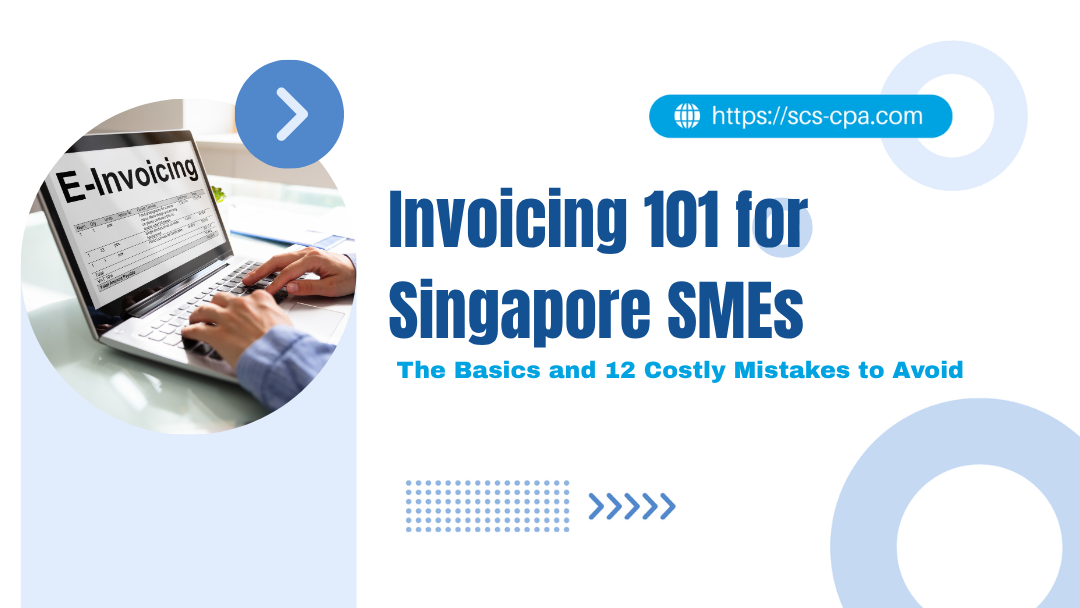
Managing invoices may seem easy, but for many SMEs in Singapore, small mistakes can lead to big problems. These issues can lead to late payments, cash flow issues, and even penalties from IRAS. In this guide, we will cover the various aspects on invoicing, including
- The Essential Basics
- Common mistakes you may make
- Practices for a better invoicing process.
Essential Invoicing Basics for Singapore SMEs

Invoice vs Receipt: What’s the Difference and Why It Matters
Have you ever confused an invoice and a receipt? We have been there. While the two are records of your transactions, they have stark differences, including
| Feature | Invoice | Receipt |
| Purpose | Request for payment | Proof of payment received |
| When Issued | Before the customer pays | After payment is made |
| Key Content | Description of goods or services, total amount, GST (if any), payment terms | Amount paid, date, method of payment |
| Business Impact | Drives cash inflow | Confirms and closes the transaction |
| IRAS Requirement | Mandatory for billing, especially for GST-registered firms | Must be issued upon request as proof of payment |
Key Information Your Invoice Must Include (IRAS Compliance)
According to IRAS, every tax invoice should contain
- your business name, address,
- GST registration number,
- a unique invoice date and serial number,
- the customer’s billing details,
- a clear description of goods or services, including quantity, unit price, and the total payable amount,
- GST amount, if applicable, and
- payment terms with the due date.
Tip: Always be specific and as detailed as possible for accurate documentation. Otherwise, you will confuse your customers (and yourself) and disrupt the company’s workflow.
IRAS GST and IMDA InvoiceNow E-Invoicing
|
Criteria |
Traditional Invoicing |
InvoiceNow (IMDA) |
|
Format |
Paper or PDF sent by email |
Structured e-invoice (Peppol standard) |
|
Processing |
Manual entry, prone to errors |
Direct system-to-system transfer |
|
Speed |
Often delayed |
Near-instant |
|
Compliance |
Details can be missed |
IRAS-compliant format built in |
|
Cross-Border |
Manual adjustments needed |
Supports international invoicing via Peppol |
|
Security |
Relies on email or cloud storage |
End-to-end encrypted |
Glossary of Common Invoicing Terms
- Tax Invoice: An invoice with GST details for GST-registered companies
- Credit Note: A correction that reduces a previously issued invoice
- Debit Note: A correction that increases a previously issued invoice
- E-Invoice: A digital invoice sent through InvoiceNow
Avoid These Common Mistakes Before Sending Invoices

Skipping checks and record matching often leads to disputes and delays. Hence, always reconcile all invoices against purchase orders, delivery notes, and contracts.
Using inconsistent templates creates confusion and increases the risks of non-compliance. Use templates in software such as Xero, QuickBooks, or any system that is ready for InvoiceNow. These platforms help standardise formats across all documents.
Vague payment terms let customers delay payment. As a general rule, always state a due date, acceptable payment methods, and any late fees or discounts.
Invoicing Errors During Billing

Delaying invoice submission slows down cash flow and may cause bottlenecks for your EOFY. Instead, send the invoices as soon as you deliver goods or services and automate manual processes to prevent delays. The quicker you send invoices, the sooner clients can process them.
Missing or incorrect details, such as wrong totals or missing GST numbers, cause rejections. Before sending out invoices, proofread them at least once or twice to ensure all information is correct and complete.
Not adapting to customer preferences slows down collections because customers have varying payment preferences. To speed up payment, various options like PayNow QR, credit card, bank transfer, or eGIRO.
Post-Invoicing Mistakes That Cost You

Failing to follow up on late payments often leaves money unclaimed. Many SMEs lose money by assuming clients will pay eventually. Therefore, consistent reminders, whether automated or manual, keep invoices top of mind and reduce overdue amounts.
Using outdated systems causes inefficiency and increases the risk of non-compliance as Singapore transitions toward InvoiceNow. If you are still invoicing manually, upgrading early reduces compliance risks and administrative headaches
Failing to keep records puts SMEs at risk during IRAS audits. Invoices must be retained for five years, so use secure cloud storage.
Other Challenges for Singapore SMEs
Poor communication between sales and finance often delays the billing process. Moreover, weak planning also results in inconsistent invoicing practices.
Yet, both can be resolved by creating standard operating procedures and aligning workflows.
Practical Tips and Best Practices

- Leverage platforms like InvoiceNow to automate recurring invoices and perform calculations.
- Proofreading your invoices before you send them out reduces errors and ensures consistency.
- Set reminders and plan carefully. Doing so enables you to send your invoices with time to prepare for the End-Of-Financial-Year (EOFY).
- For GST and invoicing rules, get professional advice to ensure your company remains compliant.
Common Invoicing Mistakes at a Glance
| Mistake | Why It’s a Problem | How to Fix It |
| Mixing invoices and receipts | Confuses customers and affects compliance | Use invoices for billing, receipts for proof |
| Missing IRAS details | Invoices rejected, audit risks | Include GST details, totals, and terms |
| No standard template | Errors, unprofessional look | Use standardised software |
| Vague payment terms | Clients pay late | Clearly state due dates and methods |
| Ignoring tax rules | Cross-border issues | Define currency and comply with GST |
| Delayed submission | Slows cash flow | Automate invoicing |
| Incorrect details | Disputes and rejections | Proofread and validate |
| Limited payment options | Delayed payments | Offer multiple channels |
| No follow-up | Unpaid invoices pile up | Use automated reminders |
| Outdated systems | Compliance risks | Upgrade to InvoiceNow |
| Not retaining records | Penalties during audits | Keep copies for 5 years |
| Poor communication | Missed billing | Align sales and finance teams |
FAQs
Do I need to issue invoices if I’m not GST-registered?
Yes. These are ordinary invoices without GST details.
How secure is e-invoicing with InvoiceNow?
Very secure. It uses the internationally recognised Peppol framework.
Can I issue invoices in foreign currencies?
Yes, but always state the exchange rate clearly.
What happens if I don’t keep invoices?
You risk penalties during an IRAS audit. Records must be kept for at least five years.
How can I get clients to pay faster?
Provide clear terms, offer multiple payment methods, and follow up consistently.
Is InvoiceNow mandatory in Singapore?
It is being phased in for GST-registered businesses. Early adoption helps with compliance.
Conclusion: Invoicing Done Right = Healthy Cash Flow
For Singapore SMEs, invoicing is more than paperwork. It drives cash flow and safeguards compliance. By avoiding common mistakes and adopting InvoiceNow, you can accelerate payments, reduce disputes, and stay compliant with IRAS requirements.
Resources:
Have A Question?
Connect with us for more guidance
on invoicing essentials
in Singapore.
Understanding the Core Types of Audits and Their Roles in Accounting in Singapore
Learn the key types of audits in Singapore to build trust and stay compliant. Examples are statutory, internal, GST, and forensic.
Tax Return In Singapore: A Friendly 2025 Guide
Want to be a responsible business owner? Read this guide to tax return in Singapore to help understand tax filing and play your part.
How to Change Your Company Name in Singapore
A company's name can significantly shape its identity, yet there are times when a change becomes...



